
© Jeff Busby. (Click image for larger version)
Australian Ballet
Nijinsky
★★★✰✰
Melbourne, State Theatre
7 September 2016
australianballet.com.au
www.artscentremelbourne.com.au
Even after his death, Vaslav Nijinsky suffered from the power and control of others. As if it wasn’t enough to be manipulated by Diaghilev, his lover, rushed into a marriage by his wife, Romola, and sanctified into a cross between a victim and idol by his adoring fans, his remains were replanted in Paris three years after his burial in London.
In a corner of the Montmartre Cemetery, he sits, as a statue, on his own gravestone, his grey eyes blank and his stone body dressed as Petrouchka, the puppet betrayed by his master. The statue was the idea of Serge Lifar, another lover of Diaghilev. Lifar, it seems, had plans to eventually lie in the ground by Nijinsky’s side.
Difficult as it is to express the fate of the tragic Nijinsky in movement rather than words, John Neumeier took on the challenge and in 2000 succeeded with a landmark production of Nijinsky for his Hamburg Ballet. The success wasn’t only Neumeier’s but also the dancers. Few companies have as many actor/dancers as the Hamburg Ballet, among them the principal, Alexandre Riabko.
The controlling forces that weighed upon Nijinsky’s life were vividly clear on the face of Riabko in the lead role of Vaslav on the opening night of the Australian Ballet’s premiere season of Nijinsky this week. Riabko has lived the ballet since its premiere 16 years ago, first in secondary roles and more recently as Vaslav himself. We saw him in the title role in Australia four years ago when the Hamburg troupe danced Nijinsky in Brisbane.

© Jeff Busby. (Click image for larger version)
His stamina, interpretation and powerful presence is just as strong now as it was then. Riabko’s presence on the State Theatre stage in Melbourne was all the more remarkable for the company itself as it was, I believe, the first time a guest artist has performed a principal role on an Australian Ballet opening night, and especially in the premiere of a work by the company. Union rules have prevented that happening over the years but those rules may well have changed.
Riabko will dance as Vaslav in two more shows, while Kevin Jackson and corps de ballet member, Jake Mangakahia, sharing the role through the Melbourne season.
The role of Vaslav could easily be over played or under done but Riabko finds the right balance between two extremes in the way he interprets the memories and despair of the dancer when, after his short glorious years of fame and adoration, schizophrenia held him captive.
Neumeier begins the ballet with the entry on stage of a chattering, gossiping, giggling group preparing to watch Nijinsky dance his final public performance in 1919 at the Suvretta House hotel in St Moritz. The white ballroom setting – a miniature replica of the real theatre auditorium with its balcony, seating and decorative circular light – soon slides away as the house lights dim and we enter the mind of Nijinsky recalling his years at the Mariinsky Theatre, then with Diaghilev’s Ballets Russes, when he danced as the Golden Slave in Scheherazade, the Spirit of the Rose in Spectre de la Rose and the Faun in L’Apres-midi d’un faune.

© Jeff Busby. (Click image for larger version)
Intertwined with references to the ballets are pas de deux and pas de trois in which Vaslav is either the victim, the instigator or the onlooker. He is controlled by an abusive Diaghilev (excellently portrayed by Adam Bull who towers over Riabko), tangled up in a complex relationship with his wife, Romola, (another powerful portrayal by Amy Harris who first appears in a luscious, cherry red velvet dress reminiscent of the Edwardian age), a masked Harlequin and leaping Spirit of the Rose (both danced by the virtuosic Chengwu Guo), the Young Man in Jeux (the suave Christopher Rodgers-Wilson) and a sensual Golden Slave and Faun (Cristiano Martino, a slinky Faun who seems to emit a kind of pheromome that would attract any nymph as she passes by).
In all these encounters the most outstanding are the chilling pas de deux of Vaslav and Diaghilev in which Diaghilev is more an abuser than lover, and the pas de trois for the seductive Romola, with Vaslav and his alter ego, the Faun
Interspersed with all this history are Vaslav’s siblings, Bronislava Nijinska (Leanne Stojmenov) and the even-crazier-than-his brother, Stanislav (Francois-Eloi Lavignac). Stojmenov eminates the powerful presence of Nijinska, the future choreographer and strong woman of the ballet world in the 1920s.

© Jeff Busby. (Click image for larger version)
Lavignac, still a coryphee, throws himself into the frightening disintegration of Stanislav with abandon, intensity and an element of danger (with all that floor work involving the head). Sometimes a role seems made for a particular dancer and this was one example of that lucky match.
The Australian Ballet is still finding its way into some aspects of the production, one that was exclusively danced by the Hamburg Ballet until 2013 when the National Ballet of Canada was given the rights. (The Australian Ballet is using the NBC’s sets and costumes). Nijinsky is a long work in two parts, one interval, and the first part loses some energy before it picks up again with the scene depicting the ship voyage of the Ballets Russes to South America where Vaslav and Romola were married with disastrous consequences.
With the ferocious music of Shostakovich’s Symphony No. 11, the ballet bursts into new life as Neumeier depicts Nijinsky’s reaction to the Great War and his words spoken to the audience at Suvretta House: “Now I will dance you the war, with its suffering, with its destruction, with its death”.

© Jeff Busby. (Click image for larger version)
The men, wearing open military jackets and little else, march across the stage and then form a circle in which the character, Petrouchka (the strong actor, soloist, Brett Simon) emerges wearing his clownlike costume except it isn’t the bright red, yellow and white of Benois’ costume but one that has faded into monotones.
Neumeier, who designed the sets, costumes and lighting for Nijinsky, dresses the dancers in much the same costumes as Diaghilev’s Ballets Russes’ dancers wore in the original ballets, but Diaghilev and Nijinsky, in their darkest moments, wear black , the marker of mourning and death. Neumeier’s lighting is anchored by neon circles that represent Nijinsky’s obession with painting circles. From the audience’s point of view, the lights seem to stay in the eye in the way that a bright light shone in the darkness of night remains in the eye even when the eye is closed.

© Jeff Busby. (Click image for larger version)
Neumeier’s choreography replicates the circle image, with arms repeatedly held in a wider than normal fifth position. His gestures reflect those of the flat hands of the Faun and the resting of head on head, as in Les Noces, while Vaslav’s arms spread wide, as if he is posing as Christ on the cross. And while ballet steps and poses are threaded through it, Nijinsky is a more of a contemporary dance work than a classical ballet. And just for a change, when Vaslav sinks into a small bundle of humanity to be pulled around on a trolley, Romola cheers herself up by dancing a few steps that might have been danced by a flapper in Thoroughly Modern Millie.
Led by Nicolette Fraillon, Orchestra Victoria excelled, liberated as they were from more mundane ballet scores of the Minkus kind by the power of Shostakovich.






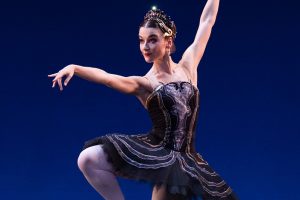

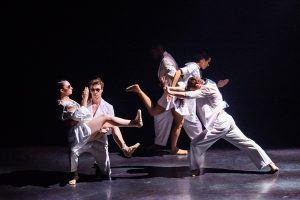
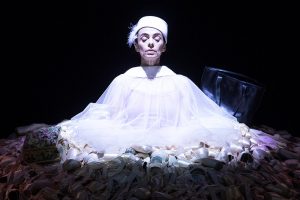

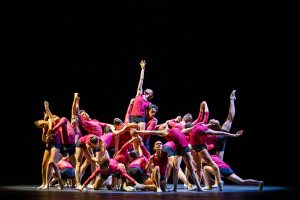

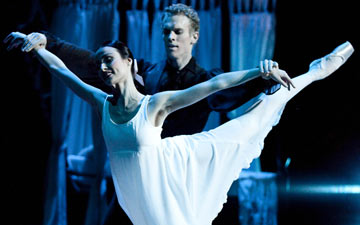



Three stars here and 4.5 in Limelight magazine. It will be interesting to see.